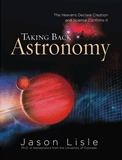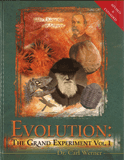News to Note, April 23, 2011
A weekly feature examining news from the biblical viewpoint
The mother tongue, not-so-ancient algae, middle ear missing links, mutation-prone moths, land plant ancestors, and more.
This week:
- The mother tongue?
- Not-so-ancient algae
- Middle ear missing links?
- Mutation-prone moths
- Land plant ancestors
- And Don’t Miss . . .
Did you miss it? Catch last week’s News to Note or any other!
1. The Mother Tongue?
Two separate linguistics studies provide findings consistent with a biblical worldview.
Psychologist Quentin Atkinson counted distinct units of sound, called phonemes, in 504 of the world’s nearly 7,000 languages. He found that sub-Saharan African languages average the most phonemes, while language groups farther away have fewer phonemes. These findings, published in Science, are consistent with the principle that “when a very small number of individuals break off from a larger population, there is a gradual loss” of linguistic complexity.
2. Not-So-Ancient Algae
Tiny fossils of algae found at the edge of Loch Torridon in Scotland have been hailed as evidence that life evolved in freshwater and on land a billion years ago.
3. Middle Ear Missing Links?
The fossilized mammal Liaoconodon hui, found in China, is being hailed as the missing link in middle ear evolution from reptiles to mammals.
4. ScienceNews: “New light on moths gone soot-colored”
The region of DNA responsible for the wing color of the famous peppered moth has been located, but the peppered moth is still a moth.
The peppered moth became famous as the “classic example of evolution” when populations of dark and light varieties were found to vary with the amount of air pollution darkening the trees of early industrial England. The contention supported by Dr. Kettlewell’s original research in the 1950s was that birds feasted on the least-well-camouflaged variety of moth. Some have questioned Kettlewell’s methods, and subsequent research has varied in its ability to replicate his results.
Here researchers report finding a mutation-prone region in the genomes of butterflies and moths that controls wing color. Natural selection allows those varieties of creatures better adapted to an environment to survive and reproduce. What we should remember is that mutations in the moth’s genome do not produce new creatures: they produce moths of a different color. That’s not evolution; it’s just moths.
For more information:
5. PhysOrg: “Ancestors of land plants revealed”
Genetic analysis has suggested that land plants evolved from a different sort of green algae than previously thought.
Among evolutionists it is “generally accepted” that land plants evolved from some sort of freshwater algae about 500 million years age. Because of gross similarities in reproductive methods, the ancestor of land plants has been assumed to be the more complex forms of algae. (Both utilize large eggs and small swimming sperm.) This study of 129 genes from 40 types of plants has found that land plants have more genetic similarities with Zygematales, a simpler kind of algae which uses amoeba-like gametes (sperm and eggs) of equal size to reproduce.
In order to make this scenario work, the researchers assume that the simpler algae once had the ability to reproduce in a way similar to land plants and then lost the ability to do so but maintained many of the more subtle similarities seen at a genetic level. The assumption is thus that the missing link became extinct leaving no trace of itself.
Of course, the greatest assumption of this work is that one kind of organism evolved into another. The Bible tells us in Genesis 1 that God created organisms to reproduce after their kind. Neither similarity of reproduction methods nor the presence of any other genetically determined traits demands sequential development of one kind of life form into another.
And Don’t Miss . . .
Not all chitons have eyes. Those that do are covered with hundreds. Their lenses are made of aragonite, a form of calcium carbonate. Fossilized trilobites have calcite lenses, but aragonite lenses are unique. The West Indian fuzzy chiton responds to dark shapes but not to mere changes in light intensity. Eyeless chitons, which are nevertheless covered with light sensitive cells, respond to changes in light intensity only.
Chitons supposedly have taken a few hundred million years to develop eyes, only acquiring them 10 million years ago, “making their eyes among the most recent to evolve.” Evolutionary assumptions claim that other species evolved eyes independently during the Cambrian explosion. Why chitons evolved their eyes so “late,” why only some varieties evolved eyes when the purely light-sensitive varieties seem to survive quite nicely without them, and how they managed to acquire the genetic information to build lenses out of aragonite remain mysteries.
- A dinosaur skull found in New Mexico shares features with certain South American theropods and “more advanced predators.” “The huge front teeth of Daemonosaurus would have been useful for seizing and killing prey. Moreover, its short deep snout ‘suggests powerful biting,’” says paleontologist Sues. Since T. rex has a long snout and small teeth, this fossil reveals “that theropods experimented with a variety of skull shapes early in their evolution, attaining considerable diversity in the Late Triassic.” Of course, conjectures about its diet cannot be confirmed. Furthermore, if the fossil does belong to a previously unknown kind of dinosaur, then the fact that its skull shares features with other kinds of dinosaurs does not require that it be an evolutionary link between them.
- Featured on the cover of Time, Rob Bell’s book Love Wins: A Book About Heaven, Hell, and the Fate of Every Person Who Ever Lived redefines hell to make judgment go away. This “theologically disastrous” position makes Christianity into nothing more than an ethical system with no need for Christ and His atoning sacrifice on the Cross. Rob Bell may redefine words, but he cannot change God’s truth. And warning people about hell is not unloving: it is the most loving thing we can do! (Read more about this issue on Ken Ham’s blog.)
Asserting that the expansion of the universe will cause much of the evidence for the big bang to eventually disappear, a recent study claims that new evidence will still exist. “Astronomers of the future won’t have to take the Big Bang on faith,” asserts Avi Loeb.
Big bang supporters point to cosmic background radiation (CBR) as evidence for the big bang theory. But they neglect to point out that the uniform temperature of this CBR throughout the known universe is actually a big problem for the big bang.
According to a study to be published in the Journal of Cosmology and Astroparticle Physics, the problem will go away in about a trillion years. The CBR will have “faded away” and the universe expanded too much to see the “ancient galaxies.” But by measuring the speed of hypervelocity stars created by the interaction of binary stars with black holes, “with careful measurements and clever analysis” they will still be able to deduce the history of the universe.
The big bang idea is an attempt to explain the origin and even the future of the universe without God. Sadly, many Christians compromise by trying to add the billions of years from the big bang to the Bible. Read more about the assumptions behind the big bang and how it conflicts with God’s account of history in The Age of the Universe, Part 1.
For More Information: Get Answers
Remember, if you see a news story that might merit some attention, let us know about it! (Note: if the story originates from the Associated Press, FOX News, MSNBC, the New York Times, or another major national media outlet, we will most likely have already heard about it.) And thanks to all of our readers who have submitted great news tips to us. If you didn’t catch all the latest News to Know, why not take a look to see what you’ve missed?
(Please note that links will take you directly to the source. Answers in Genesis is not responsible for content on the websites to which we refer. For more information, please see our Privacy Policy.)
Recommended Resources

Answers in Genesis is an apologetics ministry, dedicated to helping Christians defend their faith and proclaim the good news of Jesus Christ.
- Customer Service 800.778.3390
- © 2024 Answers in Genesis



